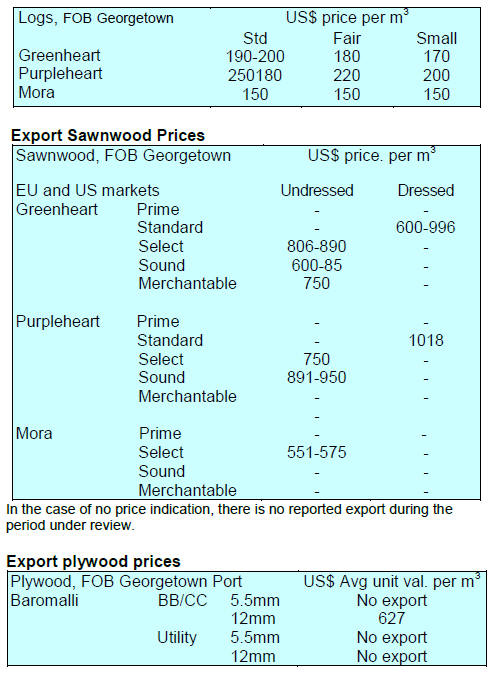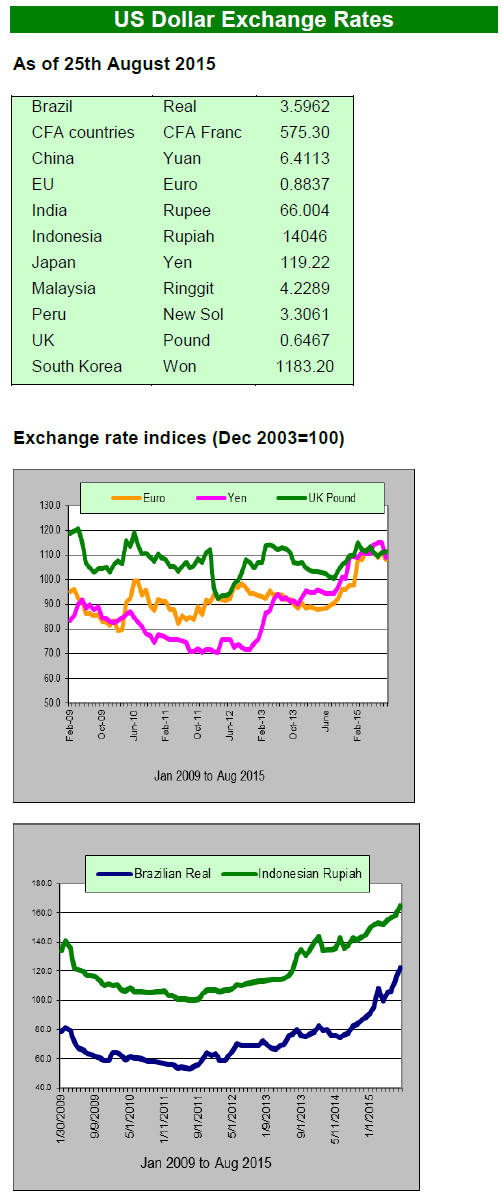2. GHANA
Sawnwood accounts for 50% of first half
exports
Air and kiln dried sawnwood exports in the first half year
of 2015 accounted for more than 50% of Ghana‟s total
wood export volumes. The top export species were
plantation teak, wawa, ceiba, plantation gmelina and
mahogany. The main markets in the first half of the year
were India, China, the U S, Nigeria and Niger.
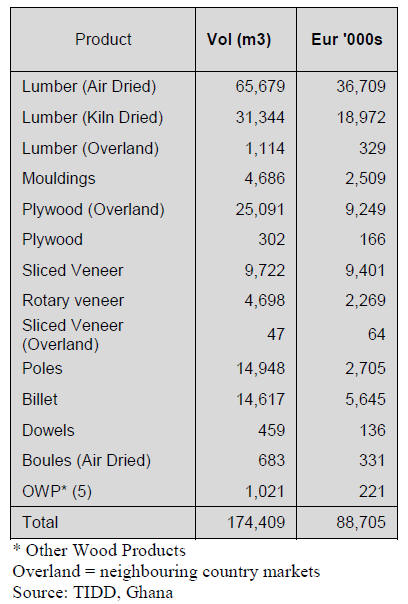
According to data from the Timber Industry
Development
Division (TIDD) of the Ghana Forestry Commission
(GFC), first half 2015 exports of wood products totalled
174,409 cu.m, a 21.5% rise on first half 2014 exports. First
half export earnings totalled euro 88.71 million.
Four products topped the export list in the first
half of this
year : sawnwood (air and kiln dry), plywood ( for regional
markets), poles and billets. These products accounted for a
volume of 151,679 cu.m, worth euro 73.28 million or 83%
of total earnings.
In summary, the breakdown of export destinations was as
follows: Europe 12.5%, Asia/Far East 58.5%, Africa 20%,
USA 6% and Middle East countries 3%.
Legality verification mechanism in place
Ghana has made progress on the system to verify the
legality of wood products and this could pave the way for
the issuance of FLEGT licenses as early as 2016.
According to Dr. Richard Gyimah, Manager of the
Verification and Audit Timber Validation Department at
the Forestry Commission (FC), just a few issues need to be
addressed before the country can secure approval to issue
FLEGT licenses.
Over the years, the GFC has been working with the EU to
put in place the systems and reforms necessary to
implement the Voluntary Partnership Agreement (VPA), a
legally binding agreement between the European Union
and timber exporting countries.
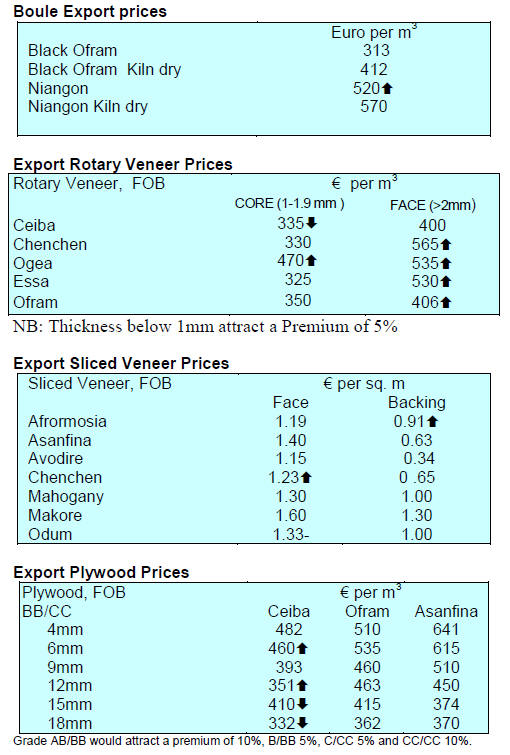

3. MALAYSIA
Ringgit under extreme pressure
In the midst of falling global stocks and currencies the
Malaysian ringgit is at a 17-year low against the US dollar,
trading at 4.2630 to one dollar on 26 August.
Malaysia‟s foreign currency reserves have fallen almost
20% since January. Malaysia‟s reserves have now dropped
at a pace four times as fast as in Indonesia where the
rupiah is under strong downward pressure.
The Malaysian government has cut its 2015 GDP growth
forecast by over 1% mainly due to continuing low oil
prices. Malaysia is the largest net exporter of oil and gas in
Southeast Asia, with energy exports accounting for
roughly 30% of national revenues.
Oil Palm stems, 10 million cubic metres available
The latest issue of MASKAYU, the official publication of
the Malaysian Timber Industry Board, reported on a
seminar on conversion of oil palm trunk (OPT) into
sawntimber and plywood.
The seminar provided a platform for local entrepreneurs in
the wood-based industry to obtain the latest information
and R&D findings in manufacturing OPT products.
Data from the Ministry of Plantation Industries and
Commodities shows that Malaysia‟s oil palm resources
extend over 5.3 million hectares or about 70% of all
agriculture land.
Yields from oil palm drop after 25 years so replanting is
necessary. Assuming annual replanting of 130,000
hectares, between 2015-2032 the annual availability of
OPT is estimated at 10 million cubic metres a resource
that must be utilised.
Platform for international collaborative
research
ĄŽRimba SarawakĄŻ launched
In another step signaling Sarawak‟s move towards
improving accountability and transparency in forestry
governance the State government has launched „RIMBA
SARAWAK‟ an initiative to provide a platform for
international collaborative research to develop practical
conservation management procedures for bio-rich areas.
Initially the research will be based in three field stations in
Ulu Sebuyau National Park, Batang Ai National Park and
Lanjak Entimau Wildlife Sanctuary (LEWS) which
extends over an area of 169,000 hectares and was
developed after an ITTO project in 1993.
LEWS is contiguous with Betung Kerihun National Park
(BKNP) in Kalimantan, Indonesia. Together, they formed
the world‟s first trans-boundary nature reserve in the wet
tropics for inter-regional collaboration.
The organsations which signed up for RIMBA
SARAWAK were: the Smithsonian Conservation Biology
Institute, Royal Botanic Garden Edinburgh, National
University of Singapore, and Wildlife Conservation
Society.
Sarawak first half exports fall 13 percent
Statistics compiled by Sarawak Timber Association (STA)
show a drop of 13% in value of timber and timber product
exports in the first half of the year. The product categories
ares shown below.
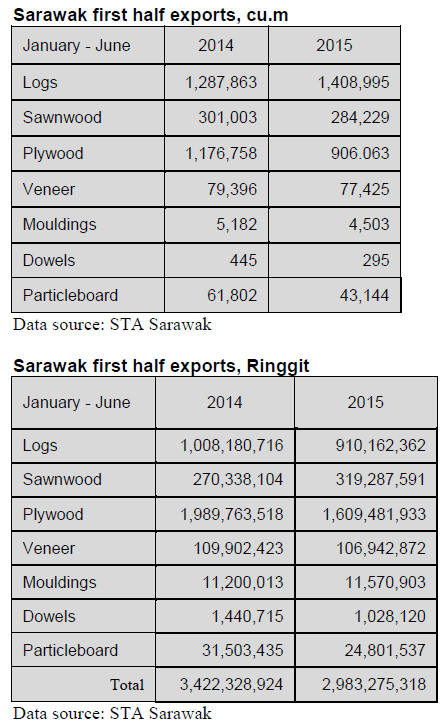
Sarawak export plywood prices
Plywood traders in Sarawak reported the following FOB
export prices:
FB (11.5 mm) US$600 per cu.m
South Korea (9 mm and above) US$435 per cu.m
Taiwan (9 mm and above) US$435 per cu.m
Hong Kong US$450 per cu.m
Sabah exports drop 16%
The Sabah Department of Statistics data for first half
exports reveal an almost 16% decline in the value of
timber and timber product exports. Product categories are
shown below.
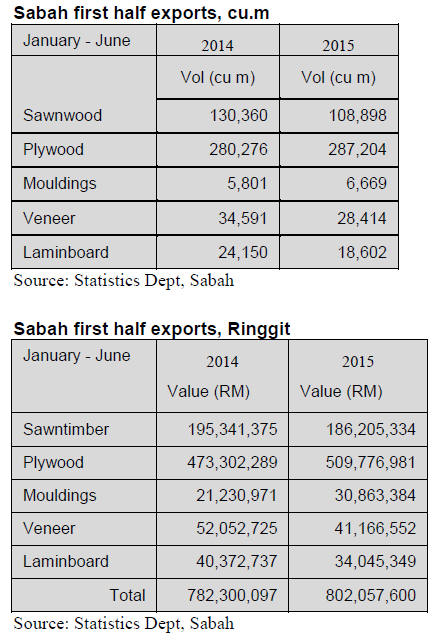
4. INDONESIA
Once again - haze from forest fires a
health hazard
Thick smog is blanketing much of Indonesia and Malaysia
as forest fires spread.
Satellite images show hundreds of „hotspot‟ forest fires in
Sumatra and Kalimantan according to statements from
Indonesia‟s National Disaster Management Agency.
Smoke from these fires is drifting across Indonesia and has
reached Malaysia.
A haze emergency was declared in Central Kalimantan
province in late August as the air pollution index (API)
rose to dangerous levels and ground level visibility was
bad enough to disrupt air traffic.
Malaysia's Natural Resources and Environment
Minister is
set to meet Indonesian officials to discuss joint action on
transboundary haze.
New tax incentives, timber sector included
Indonesian Finance Minister, Bambang Brodjonegoro, has
outlined plans for new tax incentives aimed at boosting
both domestic and foreign investment in manufacturing to
lower the country‟s dependence on commodity exports.
A new regulation, known as Finance Ministry Regulation
No. 159/2015, will target investment in industries that
support economic growth. The new regulation, which
replaces regulation PMK 192/2014, expands the list of
eligible industries and includes the forestry and wood
processing sectors.
Industrial forest plantation target missed
The Ministry of Environment and Forestry aims to have 2
million ha. of industrial plantations established by 2019
but progress has been slow as few companies are prepared
to invest. As of the end of June only 10-15 companies had
shown an interest and submitted applications to the
Ministry.
The Director General of Sustainable Production Forest
Management in the Ministry of Environment and Forestry,
Ida Bagus Putra Parthama, said the number of applications
was far below expectations. The main reason cited for the
poor response was the regulations banning plantation log
exports. Ida said that the Ministry will consult with the
Ministry of Trade to discuss a possible revision of the
export ban.
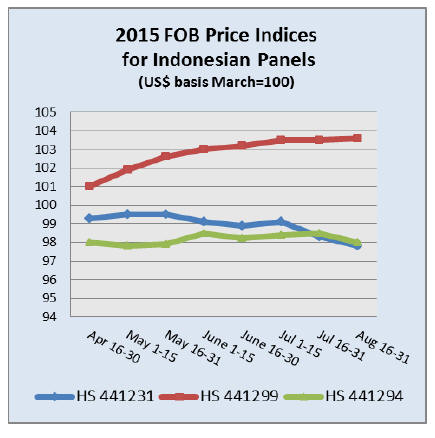
5. MYANMAR
High volume of teak veneer flitch exports
raises
questions
Photographs of partially processed logs being readied for
export have appeared in the Myanmar press (Daily Eleven
16 August) the accompanying report says teak logs which
had been debarked and had been roughly „shaved‟ with a
chainsaw were seen being loaded into containers for
export.
Myanmar introduced a log export ban in 2014 which
prohibits the export of timber classified within HS code
44.03 (wood in the rough whether or not stripped of bark
or sapwood). However, the logs being shipped were said
to have been classified as HS code 44.07 i.e. teak veneer
flitches.
One industrialist commented that it appeared the logs were
„clear-shaved‟ of knots and bumps and debarked for
export under an incorrect HS code in order to circumvent
the log export ban.
It came to light that some 3500 tons of teak veneer flitches
were shipped last year. Veneer quality teak logs make up a
very small proportion of total log harvests such that local
millers are amazed that such a high volume of veneer
quality logs could be secured. Harvested logs are mostly
of sawmill grades and analysts comment that it is
surprising that such a high volume of veneer flitches could
be obtained.
The domestic industry is calling on the authorities to
tighten checks on export shipments. Currently the
inspection process involves Forestry Department mill
inspections and the Myanma Timber Merchants
Association normally gives price recommendations for
export documentation.
While the log export regulations prohibit shipment of
baulks, squares and boules, veneer flitches fall under a
different HS code so, technically, can still be exported.
To eliminate the risk that exporters fall foul of the export
ban the industry has suggested teams of qualified
inspectors be deployed to check grades and specifications
prior to export.
Prices at most recent tender sales
The following timber was sold by Myanma Timber
Enterprise (MTE) by tender on 24 and 27 July 2015. Log
volumes are expressed in hoppus tons (H.tons) and
conversions or sawn teak (including hewn timbers) are
reported in cubic tons (C.tons).
Sales of teak conversions (scantlings)
MTE sold 352 cubic tons of various sizes of teak
conversions produced from their own sawmills.
Average prices for Second Quality (110 tons)
Long Lengths(6ft. & up avg. 8ft.) US$1638
Short lengths (3 ft. to 5.5 f.t) US$1554
Ultra shorts- (1ft. to 2.5 ft.) US$1404
The average price for Third Quality(242 tons) was
US$564 per cubic ton.
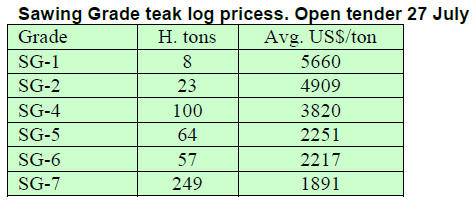
6.
INDIA
Inflation rate trends down
The Office of the Economic Adviser (OEA) to the Indian
government provides trends in the Wholesale Price Index
(WPI).
The official Wholesale Price Index for All Commodities
(Base: 2004-05 = 100) for July declined by 0.6% to 177.5
from 178.6 in June. The year on year annual rate of
inflation, based on monthly WPI, stood at -4.05%
(provisional) for June 2015 compared to -2.4% for June.
For more see:
http://eaindustry.nic.in/cmonthly.pdf
Timber and plywood price indices climb
The OEA also reports Wholesale Price Indices for a
variety of wood products. The Wholesale Price Indices for
Wood products and Plywood are shown below.
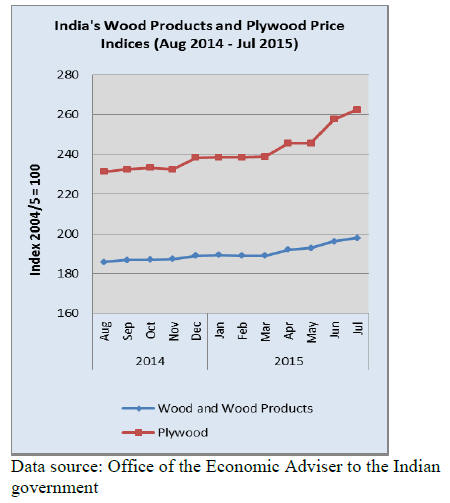
The July price indices for wood and wood products
and
plywood continue to show marked gains from a year
earlier but the signals are such that slowing demand will
weakened the pace of increases.
See
http://eaindustry.nic.in/display_data.asp
High prices holding back home sales ¨C ĄŽball now in
builders courtĄŻ
The Indian real estate sector has experienced a few tough
years and the problems continue with many homes priced
way above what people can afford.
A recent assessment says the unsold housing stock jumped
24% in Mumbai to just over 65,000 units, a record for the
city. Analysts write the situation is no better in the
Mumbai Metropolitan Region which includes Thane, New
Mumbai and Raigad, as well as Mumbai.
The latest estimate puts the number of unsold units at
around 176,000 a 20 % year on year increase. These
figures indicate a massive problem - buyer cannot afford
to purchase and builders are not ready to cut prices.
Energy saving programme to address over cutting of
fuelwood
The ministry of New and Renewable Energy (MNRE)
plans to distribute solar cookers and lamps in rural and
tribal areas in an effort to provide an alternative to
fuelwood and petroleum products.
The ministry has said "Under the programme devices such
as unnat chulhas (improved stoves), solar cookers, solar
lamps, solar home lighting systems and other energy
saving items will be distributed using the funds of
Compensatory Afforestation Fund Management and
Planning Authority (CAMPA). The scheme is managed
within the forest protection and conservation measures and
the MNRE has requested States and Union Territories to
indicate their needs for the alternative energy devices for
next five years.
Teak import prices slip as log dimensions fall
Demand for teak has fallen reflecting end-users concern
for the economy and due to the annual monsoon during
which time sales regularly slip. Because of this importers
cut back on plantation teak purchases.
Over the past month a new plantation teak supplier has
emerged, Angola which recently shipped a small
consignment (357 cu.m) of plantation teak logs worth
US4,461.
Importers say some traditional suppliers are now shipping
shorter billets and smaller girth logs and that this has
impacted the prices. Also, in recent weeks the supply of
large girth logs from those suppliers traditionally shipping
larger logs has fallen.
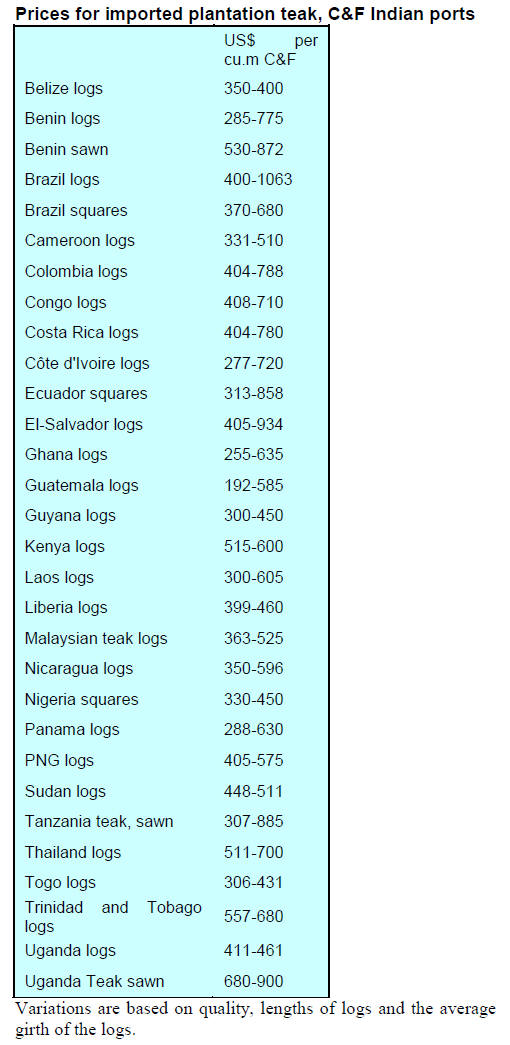
Growing interest in alternatives timbers holds
down
teak prices
Continuing strong resistance to price increases for
Myanmar teak sawnwood stems from consumers growing
acceptance of alternative species.
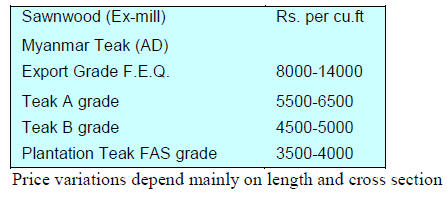
Prices for domestically milled sawnwood from
imported logs
Overall, supply and demand remains steady.

Imported sawnwood
Prices for imported sawnwood (KD 12%) shown below.
No significant price movements have been reported.

Lower phenol price but still plywood prices fall
Plywood manufacturers are benefitting from the recent
decline in phenol prices and this is providing some relief
to mills as they struggle to contain production costs.
Because of the weak housing market demand for panel
products is stalled causing millers to lower prices.
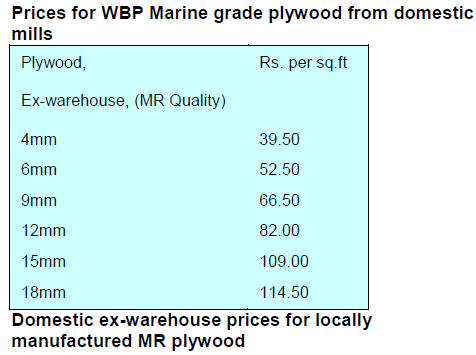

7.
BRAZIL
Interest rates continue upwards
The Consumer Price Index (IPCA) for July 2015 rose by
0.62% bringing it just below the recorded in June 2015.
The year-to-date IPCA stands at 6.83%, up from the
3.76% in the same period of 2014.
The average exchange rate in July was BRL 3.22/US$, a
significant drop on the July 2014 figure of BRL 2.22/USD.
The Brazilian currency has depreciated around 45%
against the US dollar in twelve months.
In July the Monetary Policy Committee (COPOM) of the
Central Bank of Brazil increased the basic interest rate
(Selic) by another 0.5% bringing it to an annual rate of
14.25% per year. This is the seventh consecutive rate
increase and rates are now at the highest since August
2006.
ĄŽGreenbuilding BrazilĄŻ expo proposes measures to
stem illegal timber flows
The „Greenbuilding Brazil‟ expo, the largest trade fair for
sustainable construction in Latin America, was held
between August 11-13 2015 in São Paulo and brought
together industry experts to discuss ways to increase
sustainable timber production in the Amazon.
Illegal practices in the region are still problematic and
involve non-payment of taxes, lack of consideration for
native rights, failure to protect biodiversity, over
harvesting and harvesting in protected areas.
The meeting proposed some measures to improve controls
in the supply chain. These include: creating corporate
agreements and commitments, carrying out land planning
and environmental compliance on Amazon land; creation
of timber production clusters to eliminate illegal timber
and increasing awareness on responsible wood utilisation
in the construction industry.
The concept of production clusters aims at stimulating best
practices and participants could be provided with tax
incentives and credit lines to promote the responsible
timber production.
Federal Government to release more forest
concessions
The Brazilian Forest Service (SFB) announced in early
August that the Federal government would make available
2.11 million hectares of forest concessions from 2016. In
proposing this the authorities point out that forest
concession management models facilitate forest
maintenance and protection.
It is considered that the forest concession model provides
for legal controls which may not be provided under other
land management models. In addition, such management
systems provide for dialogue between the government and
the private sector in support of rational exploitation of
forest resources.
Currently, the SFB maintains forest concession contracts
in five National Forests in the Amazonian states of Par¨˘
and Rondônia. They have set aside the total of 842,000
hectares of natural forest that will be sustainably managed
by eight companies for the next 40 years.
Export round-up
In July 2015, exports of wood-based products (except pulp
and paper) rose 3.7% in value to US$ 237.4 million
compared to US$ 228.9 million in July 2014.
Pine sawnwood export values increased almost 33%
between July 2014 (US$ 20.8 million) and July 2015 (US$
27.6 million). In terms of volume, exports increased 40%
over the same period (from 88,600 cu.m to 124,000 cu.m).
On the other hand, tropical sawnwood exports fell
marginally from 27,300 cu.m in July 2014 to 27,100 cu.m
in July 2015 (from US$ 14.8 million in July 2104 to US$
13.6 million this July)
Brazil‟s pine plywood exports fell around 4% in value in
July 2015 compared with a yeat earlier despite an increase
in the volume of exports (from 96,000 cu.m in July 2014
to 102,900 cu.m this July).
Tropical plywood are now very small but in July the
volume of tropical plywood exports rose from 3,800 cu.m
in July 2014 to 9,700 cu.m this year.
Weak regional demand for wooden furniture drove down
July export values from US$ 41.8 million in July 2014 to
US$ 38.4 million this year, a 8% decline.
ABIMCI forecast 30% rise in 2015 exports
The value of Brazilian wood products exports (including
timber, wood chips, sawnwood, plywood, door,
mouldings, and flooring) is expected to reach US$3 billion
in 2015, 30% above 2014 exports.
So far this year exports of the two main products, pine
sawnwood and plywood, increased 21% and 16%
respectively as a direct result of the appreciation of the US
dollar against the Brazilian real.
According to the Brazilian Association of Mechanically-
Processed Timber Industry (ABIMCI), pine sawnwood
went mainly to the USA, Mexico, Saudi Arabia and China.
These four countries accounted for nearly 70% exports of
pine sawnwood. Between January and July this year
exports pine sawnwood amounted to 721,000 cu.m, a 35%
year on year increase.
Pine plywood exports in July 2015 were destined mainly
to the UK, USA, Germany and Belgium which together
accounted for slightly over 50% of the total volume
exported.
Petition lodged with USTR for suspension of plywood
tax
In other news ABIMCI has filed a formal petition (July
2015) with the Office of The United States Trade
Representative (USTR), requesting a revision of the US
plywood import duty.
Since 2005 Brazilian plywood has been subject to an
import duty of 8% in the US. The import duty kicks-in
when Brazil‟s exports of plywood reach a predetermined
ceiling.
Brazilian plywood exporters surpassed the softwood
plywood quota of US$ 115 million but find that the system
is hindering the competitiveness of Brazilian products
compared to other countries.

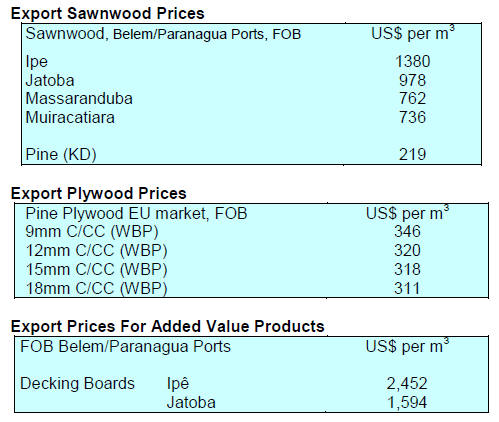
8. PERU
Falling purchase by China hits first half
year export
performance
Peruvian wood product exports in the first six months of
the year earned US$79.3 million but this was down almost
3% on earnings in the same period in 2014. The decline in
earnings from wood product exports is attributed to
slowing economic growth in China, Peru‟s main market.
According to figures from the ADEX Trade Database,
shipments to China totalled US$ 28.9 million in the first
half of the year a fall of 16%. However, in the same period
China accounted for 36% of total timber exports.
After China, the significant markets were Mexico
(US$15.5 million) and the US (US$13.1 million) but
purchases of Peru‟s wood products by both Mexico and
the US declined. Peru‟s wood product exports to Mexico
dropped 27%.
Other markets included France, Dominican Republic,
Belgium, Denmark, Australia, Ecuador, Panama, Chile,
Republic of Korea, Bolivia, Netherlands, Puerto Rico,
Sweden, Spain, Italy, amongst a total of 55 export
destinations for wood products.
Expansion of Technological Innovation Centres
An official in the Ministry of Production, Piero Ghezzi,
said work will begin in the final quarter of this year on
modernizing the country‟s Technological Innovation
Centers (CITE). The plan includes further development of
the forestry and wood processing sectors.
At the same time work will begin on development of
modern industrial parks, one in Lima (Ancon) and one
each in La Libertad, Piura, Tacna and Moquegua.
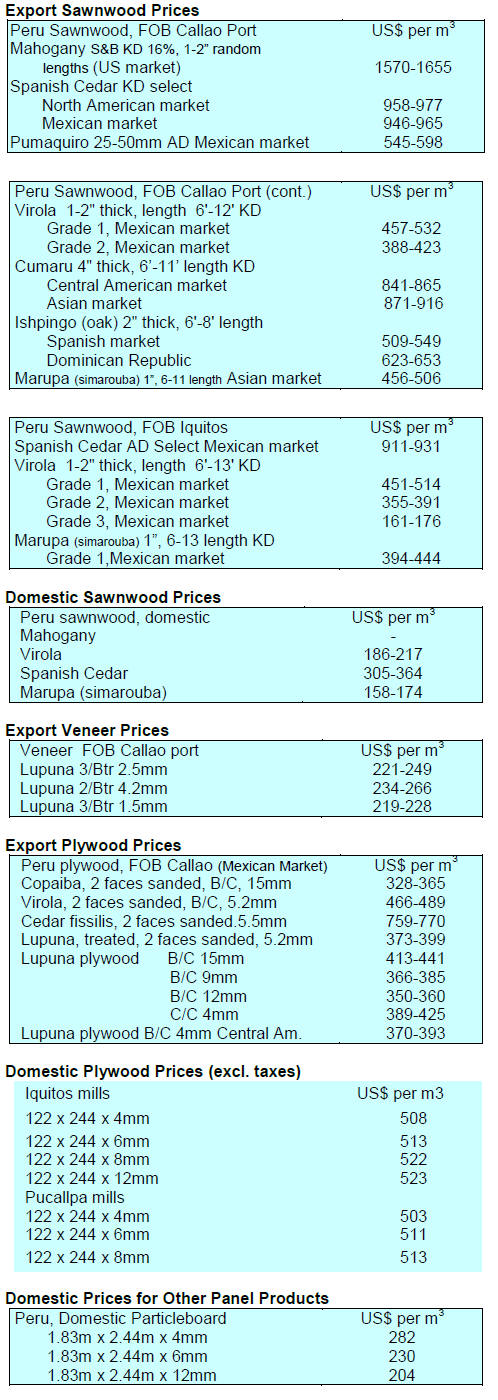

9.
GUYANA
Markets in EU and Oceania dominate first
half exports
Strong demand in Europe and Oceania for Guyana‟s
timber and wood products resulted in satisfactory first half
2015 export earnings of US$2.41 million, up 15% on the
US$2.09 million in the first half of 2014.
Demand was particularly firm for sawnwood and finished
products such as doors and indoor and garden furniture.
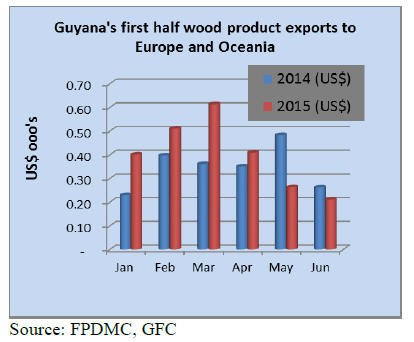
Despite the good exports performance in the first
four
months of 2015 export sales dipped in May and June the
combined effect of global economic issues and a drop in
domestic output because of national elections.
The Forest Products Development and Marketing Council
along with the Guyana Forestry Commission is promoting
the benefits of the Voluntary Partnership Agreement
(VPA) being negotiated with the EU.
When the VPA is concluded it is expected the EU market
will be absorbing more of Guyana‟s wood products there
by improving the profitability of domestic industry and
contributing more to the economic development of
Guyana.
Export prices
There were exports of greenheart, purpleheart and mora
logs in the period reviewed.
